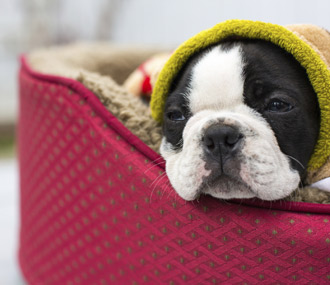Help Your New Puppy Feel at Home
Published on February 18, 2015
Skip To

Most puppies are highly adaptable and will adjust, in time, to a new home. You can make the process faster and smoother by creating a soothing environment for your puppy. There are two ways to do this: by establishing a comforting physical space for him and by being consistent in your interactions with him.
Setting Up His Space
Help to make your puppy comfortable by setting up a space where you can safely confine him; this will help with sleeping and potty training. Use a gate or fencing to close off a room or area of your home. Within this enclosed space, provide comforts like a crate, bedding, water and, if needed, piddle pads. You can also create a safe space for your puppy on the road: Take his crate or dog bed along on trips or outings to give him a familiar spot where he can relax and settle.Familiar scents can be comforting to puppies. When you bring your puppy home from the breeder or shelter, ask if you can take some of his bedding with you to help him settle in. Once your puppy is adjusted to his new family, consider putting something with your scent on it, such as a worn T-shirt, in his bed at night for him to sleep with.
Pheromones can also help relieve anxiety for some puppies. One synthetic pheromone product mimics the pheromone naturally released by the lactating mother dog, and can help some puppies adjust to changes, such as times of separation. Ask your veterinarian before using any of these products.
Finally, soothing sounds, like classical music, can also help some puppies relax. The CD series Through a Dog’s Ear has puppy-specific versions that help accustom a puppy to everyday sounds.
Socialization and Training
Help your puppy adjust to his new life by properly socializing him. It can make the difference between a dog who is cautious, fearful and possibly aggressive, and a dog who is confident, calm and relaxed. Socializing your puppy does not guarantee that he won’t have any behavioral problems later in life, but it creates an important foundation you can continue to build on as he grows.The prime window for puppy socialization is up to 12 weeks of age, but this period can extend to as long as 16 weeks. To successfully socialize your puppy, provide him with a variety of experiences. Once your vet gives the all-clear for your puppy to be in public places and around other animals, these experiences can include a walk on a busy sidewalk, a visit with people at an outdoor coffee shop, and introducing him to a wide range of people (men, women, children) and pets (other dogs). Offer frequent rewards so that your puppy learns to associate all of these situations and individuals with good things.
Start teaching good manners early. Be consistent from the start and allow only behaviors from your puppy that you will be okay with when he’s an adult. Reward your puppy for the behaviors you want while redirecting him away from or managing the situation to prevent unwanted behaviors. Avoid any techniques that include harsh punishment, as these create negative associations and fear, and may lead to aggressive behavior.
Puppy class offers another opportunity to socialize your dog and to practice good behavior. Enroll in a puppy class that relies on positive reinforcement training methods and allows for supervised puppy play.
If a behavioral problem is evident, get help early rather than waiting for it to get better on its own. The sooner a problem is addressed, the better. Talk to your veterinarian, who may recommend a positive reinforcement trainer to give your puppy the right help from the start to set him up for a lifetime of success.
More on Vetstreet:
- Crate Train Your Fearful Dog in 5 Steps
- Your Complete Guide to Socializing a Puppy
- Most Popular Puppy Names of 2014
- Vetstreet’s Top Dog Training Videos
- Puppy Basics 101





